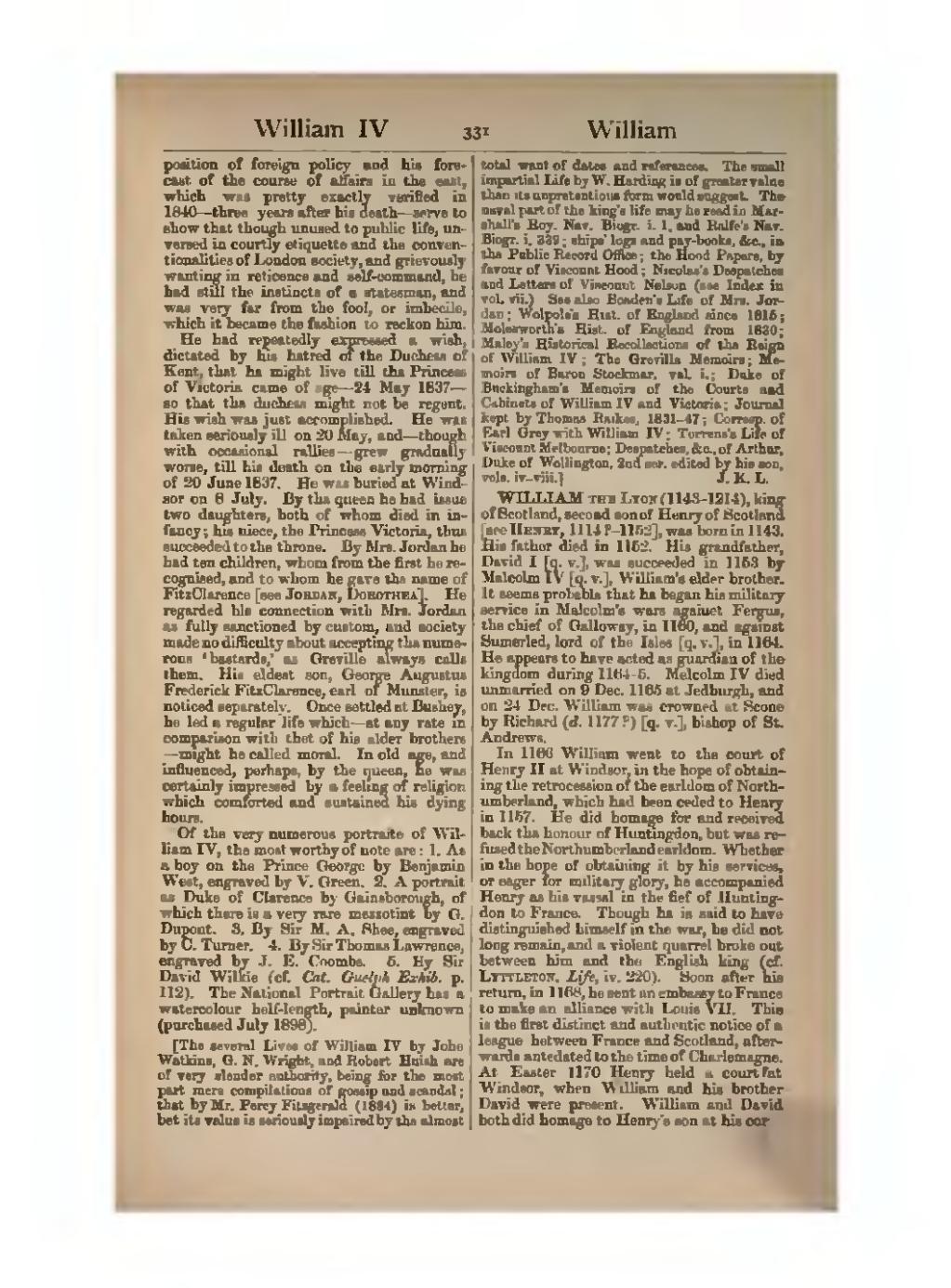position of foreign policy and his forecast of the course of affairs in the east, which was pretty exactly verified in 1840—three years after his death—serve to show that though unused to public life, unversed in courtly etiquette and the conventionalities of London society, and grievously wanting in reticence and self-command, he had still the instincts of a statesman, and was very far from the fool, or imbecile, which it became the fashion to reckon him.
He had repeatedly expressed a wish, dictated by his hatred of the Duchess of Kent, that he might live till the Princess Victoria came of age—24 May 1837—so that the duchess might not be regent. His wish was just accomplished. He was taken seriously ill on 20 May, and—though with occasional rallies—grew gradually worse, till his death on the early morning of 20 June 1837. He was buried at Windsor on 8 July. By the queen he had issue two daughters, both of whom died in infancy; his niece, the Princess Victoria, thus succeeded to the throne. By Mrs. Jordan he had ten children, whom from the first he recognised, and to whom he gave the name of FitzClarence [see Jordan, Dorothea]. He regarded his connection with Mrs. Jordan as fully sanctioned by custom, and society made no difficulty about accepting the numerous ‘bastards,’ as Greville always calls them. His eldest son, George Augustus Frederick FitzClarence, earl of Munster [q. v.], is noticed separately. Once settled at Bushey, he led a regular life which—at any rate in comparison with that of his elder brothers—might be called moral. In old age, and influenced, perhaps, by the queen, he was certainly impressed by a feeling of religion which comforted and sustained his dying hours.
Of the very numerous portraits of William IV, the most worthy of note are: 1. As a boy on the Prince George by Benjamin West, engraved by V. Green. 2. A portrait as Duke of Clarence by Gainsborough, of which there is a very rare mezzotint by G. Dupont. 3. By Sir M. A. Shee, engraved by C. Turner. 4. By Sir Thomas Lawrence, engraved by J. E. Coombs. 5. By Sir David Wilkie (cf. Cat. Guelph Exhib. p. 112). The National Portrait Gallery has a watercolour half-length, painter unknown (purchased July 1898).
[The several Lives of William IV by John Watkins, G. N. Wright, and Robert Huish are of very slender authority, being for the most part mere compilations of gossip and scandal; that by Mr. Percy Fitzgerald (1884) is better, but its value is seriously impaired by the almost total want of dates and references. The small impartial Life by W. Harding is of greater value than its unpretentious form would suggest. The naval part of the king's life may be read in Marshall's Roy. Nav. Biogr. i. 1, and Ralfe's Nav. Biogr. i. 339; ships' logs and pay-books, &c., in the Public Record Office; the Hood Papers, by favour of Viscount Hood; Nicolas's Despatches and Letters of Viscount Nelson (see Index in vol. vii.). See also Boaden's Life of Mrs. Jordan; Walpole's Hist. of England since 1815; Molesworth's Hist. of England from 1830; Maley's Historical Recollections of the Reign of William IV; The Greville Memoirs; Memoirs of Baron Stockmar, vol. i.; Duke of Buckingham's Memoirs of the Courts and Cabinets of William IV and Victoria; Journal kept by Thomas Raikes, 1831–47; Corresp. of Earl Grey with William IV; Torrens's Life of Viscount Melbourne; Despatches, &c., of Arthur, Duke of Wellington, 2nd ser. edited by his son, vols. iv–viii.]
WILLIAM the Lyon (1143–1214), king of Scotland, second son of Henry of Scotland [see Henry, 1114?–1152], was born in 1143. His father died in 1152. His grandfather, David I [q. v.], was succeeded in 1153 by Malcolm IV [q. v.], William's elder brother. It seems probable that he began his military service in Malcolm's wars against Fergus, the chief of Galloway, in 1160, and against Sumerled, lord of the Isles [q. v.], in 1164. He appears to have acted as guardian of the kingdom during 1164–5. Malcolm IV died unmarried on 9 Dec. 1165 at Jedburgh, and on 24 Dec. William was crowned at Scone by Richard (d. 1177?) [q. v.], bishop of St. Andrews.
In 1166 William went to the court of Henry II at Windsor, in the hope of obtaining the retrocession of the earldom of Northumberland, which had been ceded to Henry in 1157. He did homage for and received back the honour of Huntingdon, but was refused the Northumberland earldom. Whether in the hope of obtaining it by his services, or eager for military glory, he accompanied Henry as his vassal in the fief of Huntingdon to France. Though he is said to have distinguished himself in the war, he did not long remain, and a violent quarrel broke out between him and the English king (cf. Lyttleton, Life, iv. 220). Soon after his return, in 1168, he sent an embassy to France to make an alliance with Louis VII. This is the first distinct and authentic notice of a league between France and Scotland, afterwards antedated to the time of Charlemagne. At Easter 1170 Henry held a court at Windsor, when William and his brother David were present. William and David both did homage to Henry's son at his coro-
